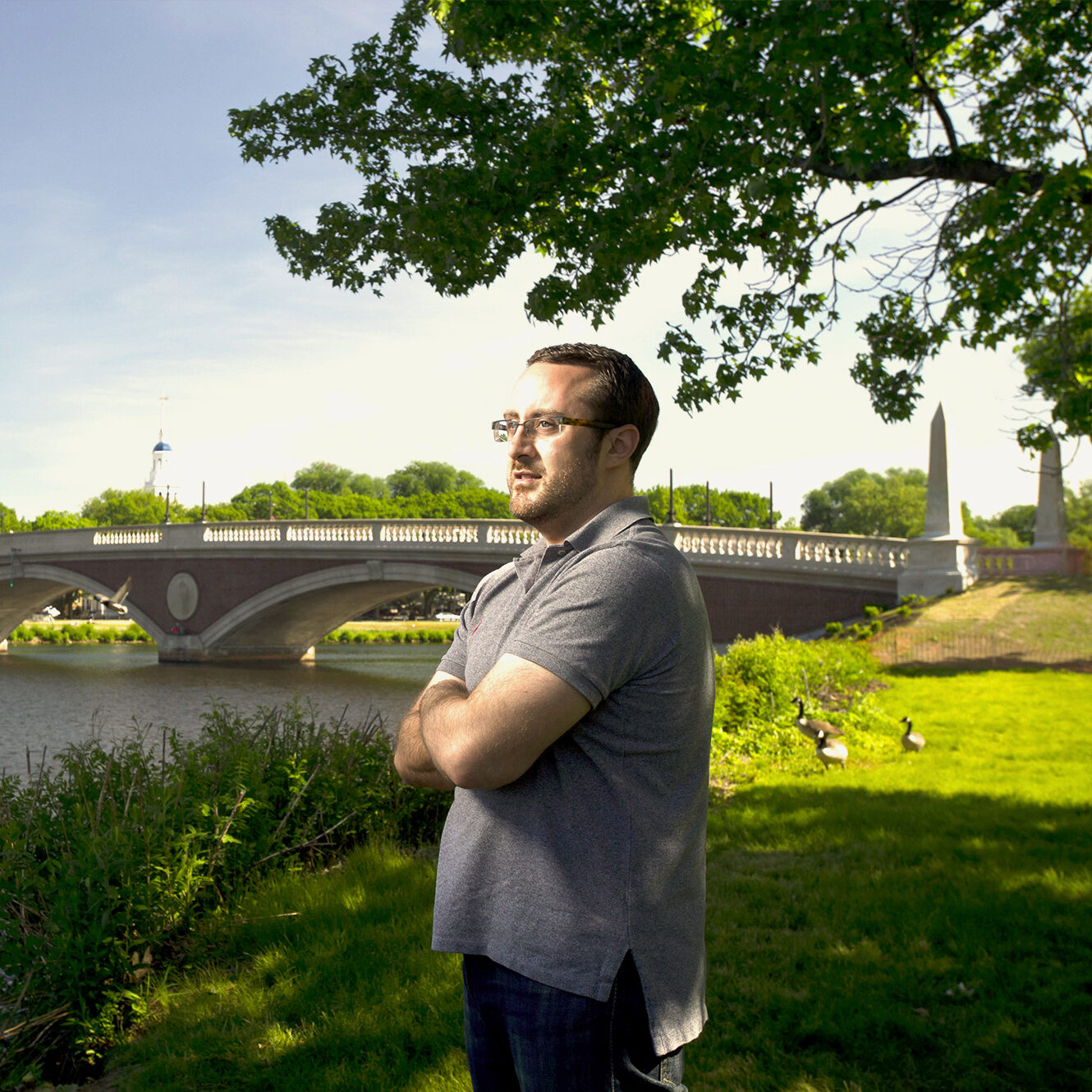Student Research Leads to a New Understanding of the Brain in Mental Health
Brown’s research on the brain of mental health patients has led to a new understanding of the roots of schizophrenia and bipolar disorder.
by Lauren McLaughlin
In 2010, Chris Brown began immersing himself in the anatomy of the human brain. By day he worked as a residential mental health counselor, helping one client who harbored paranoid delusions about fighter pilots and many others who bounced between mental institutions and jails.
By night Brown attended psychology and biology classes at Harvard Extension School, studying mental health disorders and the morphology of the brain’s structures. During precious free time, he pored through pertinent literature, teaching himself as much as he could about our arguably most complex and least-understood organ—including what happens when it doesn’t function properly.
In 2012 he started graduate research in Dr. Sabina Berretta’s Translational Neuroscience Laboratory at McLean Hospital, studying differences in the brain among patients with schizophrenia and bipolar disorder, as compared to healthy patients.
“It worked well with my full-time job,” says Brown, “because my job dealt with people suffering from the very illness I was trying to investigate. So it synergized together into this body of work over four years.”
The Amygdala: Our Emotion-Processing Center
Berretta’s team focused their studies on the amygdala, a pair of almond-shaped structures embedded deep in the brain that comprise part of the limbic system. The amygdala helps regulate emotional reactions, processes memories, and guides decision making.
Specifically, the researchers were looking at perineuronal nets, which are specialized structures in the amygdala’s extracellular matrix. Brown describes a perineuronal net as a sugar coat that envelops certain types of neurons, insulating and strengthening their connections.
“It’s been shown that people with schizophrenia have a decrease in the number of [sugar] coats surrounding certain neurons in specific subdivisions of the amygdala,” he says. “This has behavioral consequences because your amygdala is a central node in the emotion-processing circuit.”
Brown offers an example: The first time you hear an 18-wheeler rumble down your street at night, the noise would likely startle you. At first you might fear for your safety, but over time you would grow accustomed to the noise.
People who have fewer perineuronal nets in certain areas of the amygdala—like those with schizophrenia—might always become startled because their brains do not make the connection that the noise is safe.
Counting Coats Yields a Discovery
Brown’s thesis project germinated from his work in Berretta’s lab. The group had already found fewer perineuronal nets in the deeper portion of the amygdala in patients with schizophrenia, but nobody had studied the superficial portion yet, so Brown spearheaded that research.
“They would take a slice—like with a high-end deli slicer—of brain and give me a sliver on a slide,” says Brown. “I would sit down with a microscope and count all the [sugar] coats in slide after slide after slide, for months.”
Brown and his colleagues predicted they would see the same decrease in these sugar coats, or perineuronal nets, in the superficial nuclei that they saw deeper in the amygdala. After collecting all the data and running the appropriate statistics, what he found surprised everyone.
“There wasn’t a change,” Brown says, incredulously. “How can this be? You’d figure across this [short] distance of space you’d see the same thing.”
To grasp the behavioral implications of this finding, it helps to understand a simplified version of the pathway that connects an environmental stimulus—say, the loud rumbling of an 18-wheeler—to a behavioral response.
Sensory information enters the amygdala in the deeper portion (in green, in the diagram below), then gets processed in the superficial portion (in red), before sending it off to other areas in the brain (in yellow), which determine a behavioral response such as “fight or flight.”
If you think about it biologically, in the wild you’d be eaten if you were completely immobilized. So even if you’re using corrupted data, so to speak, you still have to make a move.
Brown discovered that the numbers of perineuronal nets did not decrease in the superficial nuclei the same way they did in the deeper nuclei in schizophrenic patients. Instead, their superficial amygdala mirrored that of healthy patients. Why, then, do we see an abnormal response to recurring stimuli in people with schizophrenia?
With fewer perineuronal nets in the deeper portion of the amygdala, schizophrenic patients might interpret the rumbling noise erroneously as a sign of danger. Even if they do assess the situation incorrectly, however, they are biologically motivated to elicit some type of behavioral response—either to stay and fight or to run away.
This might mean that the deeper portion of the amygdala is responsible for assigning emotional significance, whereas the superficial amygdala role primarily relays the message—regardless of accuracy—to the hypothalamus and brainstem.
“If you think about it biologically, in the wild you’d be eaten if you were completely immobilized. So even if you’re using corrupted data, so to speak, you still have to make a move,” says Brown. Without any type of response, he adds, “your chances of survival would diminish.”
It’s always a pleasure to see someone go from bright and hardworking to true scholar.
Dante Spetter, research advisor
Writing the Thesis, Winning a Prize
Brown’s thesis garnered him high praise from the Extension School—he won the Dean’s Prize for Outstanding ALM Thesis in the Behavioral Sciences in 2014. And the accolades didn’t stop there.
“It’s always a pleasure to see someone go from bright and hardworking to true scholar,” says Dr. Dante Spetter, Brown’s research advisor at the Extension School.
Brown began the thesis process like most candidates, ambitious but a bit unprepared for the enormity of the task ahead. After working with him over time, Spetter increasingly admired his diligence. “His work ethic so impressed me that I subsequently hired him as a TA [teaching assistant], and he has been my TA for three years now,” she says.
For Brown, writing the thesis was no trivial pursuit. He remembers countless revisions of both his proposal and his thesis draft, and gives much credit to Spetter for her guidance.
“Looking back on it, she made me a better writer. They’re not just going to give you a degree from Harvard,” says Brown. “You need to write on a caliber that someone in the field can pick it up and say ‘this is quality work.’ She really taught me how to do that.”
A More Dynamic Future
Brown not only works as an Extension School teaching assistant, but he also recently secured a job as an academic coordinator at a local high school. He works in a Bridge program that helps students transition back into their classroom, either because they were away for an extended absence or because they have special education needs.
Brown hopes to pursue his passions for both clinical research and education, with the ultimate goal of becoming a school guidance counselor. He is applying to the master’s program at the Harvard Graduate School of Education this fall.
Spetter certainly thinks his future is bright. “I think it is likely he will combine these interests and skills and become a school psychologist or director of student support in some fashion, developing programs to foster mental health and optimal development for young people,” she says. “I see him as a leader and a valued colleague.”

